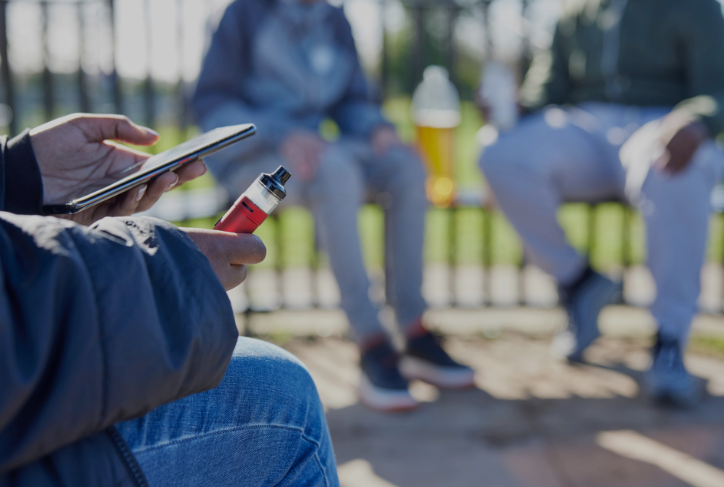
A study shows that many youngsters are becoming addicted to vaping, amid advertising aimed at them and the lack of regulatory control.
South Africa faces an epidemic of children addicted to vaping, a problem that has mushroomed in a vacuum of legislation controlling who has access to the products, which are marketed as a “safe” and “cool” lifestyle trend.
The reality of this nascent epidemic has been highlighted for the first time in the largest study of its kind by researchers at the University of Cape Town and Utrecht University in the Netherlands, which surveyed 26 000 learners in 54 schools across eight provinces — North West schools did not give permission — during 2023.
The study, recently published in The Lancet’s eClinical Medicine journal, used the responses of 25 149 grade eight to 12 learners and found 16.83% admitted to currently vaping.
Approximately 36% of learners in the sample reported that they had tried vaping, 2% said they had used tobacco cigarettes and the use of cannabis and hookah pipes was reported by 5% and 3% of respondents, respectively.
Nationally, rates of vaping ranged from 4% to 31% by school and increased with each grade.
Current use was reported by 8.47% of grade eight pupils, 13.32% of grade nines and 17.28% of grade 10 learners. Use rose to 21.51% in grade 11 and peaked at 29.51% among grade 12 learners.
Researchers also investigated signs of addiction and found that 47% of teen vapers use their device within an hour of waking up — a strong indicator of dependence — and 11.8% said they could not get through the school day without vaping.
Eighty-eight percent reported using products containing nicotine and 24.9% admitted feeling anxious or angry if they were unable to vape for a prolonged period.
Some 38.3% said they vaped daily and more than 50% vaped more than four days per week.
The rapid rise in vaping among adolescents is a new public health challenge, co-author of the study, Samantha Filby of UCT’s research unit on the economics of excisable products, said.
She said the team had sought to quantify the burden driven by global alarm bells, like the World Health Organisation’s 2023 warning about e-cigarette promotion targeting the youth and the dearth of local knowledge.
“We used this information to construct a novel vape-dependence score that could help us identify the proportion of vape users who are highly vape dependent. On our scoring system, 60% of the sampled adolescent vapers exhibit high vape dependence,” Filby said. “This underscores vaping as a significant addiction for a large portion of young users and highlights the urgent need to strengthen prevention efforts.”
The lead author of the study, UCT professor Richard van Zyl-Smit, said the scale of nicotine dependence seen in this research was “unprecedented”, even when compared with traditional cigarette use among teenagers.
“The extent of use and dependence on nicotine is something researchers had never encountered with traditional cigarettes in the past,” he said.
Van Zyl-Smit said there was no regulation of vapes in South Africa, although the Tobacco Products & Electronic Delivery Systems Control Bill, which was gazetted in 2022 but has not yet been promulgated, deals with it.
The Bill bans the marketing and sale of e-cigarette/vape products to under-18s, as well as online purchases, and restricts the sale of products near places of education, as well as regulating the marketing and sale of tobacco products.
Van Zyl-Smit said it was clear that the marketing of 7 000 to 8 000 “sweet” vape flavours including varieties such as gummy bear, bubblegum and caramel candy were targeting the youth.
And, contrary to myths that vaping is safer and preferable to smoking tobacco, health risks have been documented, he added.
“Of major concern and generally ignored by the vaping industry are the negative effects of nicotine, along with other vaping-produced chemicals, on the young brain and lungs.
“Adolescent lungs are still developing and exposure to any unnecessary toxins during the growth phase should be prevented: tobacco, cannabis, electronic cigarettes, air pollution,” he said.
“The adolescent brain, similarly, is developing and particularly sensitive to nicotine — as well as cannabis.
“The exposure to nicotine amongst learners is high and widespread, which should be cause for alarm.”
Studies have shown that dependence can occur at low levels of exposure and within 1 to 2 days, Van Zyl-Smit said, as the developing brain is vulnerable to the rewarding effects of nicotine.
Nicotine is toxic to the prefrontal cortex, with an effect on cognitive and executive functions. It can also lead to impaired cognitive function in later life, behavioural problems, depression and panic disorders.
A review by Loren Wold and colleagues on the cardiopulmonary consequences of vaping in adolescents outlines its effects on developing lungs and hearts, including increased wheezing, bronchiectasis, increased risk of infection and changes in vascular and endothelial function.
“With lung development continuing into the early twenties and the long-term effects of exposure reducing lung immunity or impacting on lung growth, exposure during adolescence should be avoided at all costs,” Van Zyl-Smit said.
Filby concurred that regulation is urgently needed to curb the emerging epidemic.
“What we need is regulation to ban ads targeting youth and enforce age limits to reduce appeal and access.
“Vape products are so easily accessible because you can even order them on the Checkers Sixty60 or UberEats mobile apps,” she said.
“The restrictions on vape marketing, which the Bill provides, can aid in debunking the myth that vaping is safe and assist with de-glamourising vaping among our youth.
“We want to ignite action; push lawmakers to regulate vaping and equip schools, parents and the public health community with knowledge that there is a need to intervene and shift public perception towards the reality that we have a public health crisis in the making,” Filby said.
No proven intervention to help adolescents stop vaping exists, Van Zyl-Smit noted.
“It is likely, given the high level of addiction we suspect, that medication to help with nicotine withdrawal symptoms might be needed but none are approved for use in under-18s,” he said.
Professor Catherine Egbe, a senior specialist scientist in the mental health, alcohol, substance use and tobacco research unit of the South African Medical Research Council, was not surprised by the findings.
She said a study last year by the council found about 26% of undergraduates aged 18 to 24 were using e-cigarettes — 13% on a daily basis.
“We’ve been sounding the alarm for a while now.
“Our previous studies have shown that young people are being targeted by the industry by the location of vape shops around educational institutions and the alluring advertisement and promotion of these products using characters and influencers that are targeted at a young population,” she said.
“With many e-liquid flavours which the youth view as exciting and appealing, and little or no restrictions by law, a sharp rise in prevalence of use among young people can be expected.”
Egbe called on the government to pass the Bill as a matter of urgency.
“We must protect our children and future generations from a lifetime of nicotine and other addictions.”
Sanele Zulu, convenor of the South African Tobacco-Free Youth Forum, said the study’s findings mirrored what was happening in communities.
“We have observed the rise in the use of vapes, as well as other nicotine delivery systems, such as oral nicotine pouches.
“We get so many concerns from teachers who continuously have to confiscate these products from their learners, and distressed parents, whose children have been entrapped by these products,” she said.
The Vapour Products Association of South Africa’s code of conduct prohibits members selling vapes to people under the age of 18, although many sellers are not members, chief executive Asanda Gcoyi said.
The association is itself a member of the Advertising Regulatory Board, which provides a vaping advertising code, and the public can lay complaints against businesses targeting young people.
“We are concerned about industry players using marketing tactics that may appeal to young people …
“The South African smoking population is large enough for industry players to make their marketing highly targeted at smokers, without the need to engage in marketing that may profile vaping as cool or attractive, given our insistence that vaping is intended as a substitute for adult smokers who want to lessen their harm through less harmful alternatives, with the aim of eventually quitting smoking altogether,” he said.
“For the past three years, we have asked that the government separate vaping regulation from the broader tobacco bill as we believed this would speed up the finalisation of the Bill.”
Department of health spokesperson Foster Mohale said the Bill was currently before parliament.



